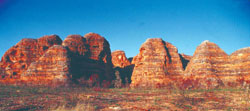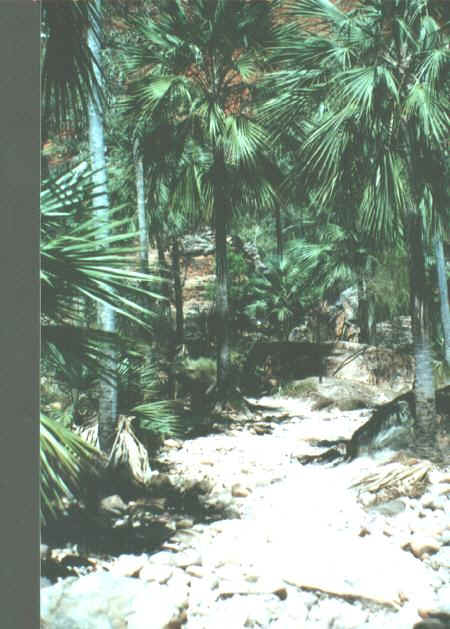

The Bungle Bungle Range, in Purnululu National Park, is one of the most fascinating geological landmarks in Western Australia. From an aircraft, the Bungle Bungle Range is an imposing sight. The orange and black stripes across the beehive-like mounds, encased in a skin of silica and algae, are clearly visible as you approach from the south. As you sweep further over the range a hidden world of gorges and pools is revealed, with fan palms clinging precariously to walls and crevices in the rocks.

Although the Bungle Bungle Range was extensively used by Aboriginal people during the wet season, when plant and animal life was abundant, few Europeans knew of its existence until the mid-1980s. The area has been a national park since 1987 and its unique appearance has captured the public imagination. The park offers a remote wilderness experience.
There are few facilities and no accommodation; visitors must carry in all food and water. Most visitors camp for several days so it is essential to be well equipped. You can camp at Walardi and Kurrajong campsites.
The park is open only between April and November.
In the Kija Aboriginal language purnululu means sandstone. The name Bungle Bungle comes either from the corruption of an Aboriginal name for the area, or from a misspelling of one of the common Kimberley grasses found here, bundle bundle grass.
The Bungle Bungle Range rises up to 578 metres above sea level. The range stands 200 to 300 metres above a woodland and grass-covered plain, with steep cliffs on the western face. Elsewhere, particularly where Piccaninny Creek has formed Piccaninny Gorge, the range is cut by deep gullies and breaks up into complex areas of ridges and domes, with prominent orange and black or grey bands.

Virtually every visitor to Purnululu asks the same question - how did this remarkable landscape come about? The distinctive beehive-shaped towers of the Bungle Bungle are made up of sandstones (rocks formed by the consolidation of sand grains) and conglomerates (rocks composed mainly of pebbles and boulders and cemented together by finer material). These sedimentary formations were deposited into the Ord Basin 375 to 350 million years ago, when active faults were altering the landscape.
To the north of what is now the Bungle Bungle Range, uplift occurred along the Osmond Fault to create the Osmond Range, and to the west took place along the Halls Creek Fault. Streams and rivers eroded these ancient highlands and at their edges slopes were steep and the energy in the streams and rivers was high, allowing them to carry large boulders and dump them at the foot of the scarp. Such boulder conglomerates can today be seen in the walls of Echidna Chasm.
Most of the rocks in the Bungle Bungle Range, however, were formed from sand deposited further from the highlands by lower-energy braided rivers flowing across broad plains in open valleys. As more sand accumulated, the older channels consolidated to form sandstone.
The distinctive beehive-shaped landforms seen today have been produced by uplift and erosion during the last 20 million years. Contrary to its solid appearance, the sandstone is extremely fragile. The weight of overlying rock holds the sand grains in place, but when this is removed, the sandstones are easily eroded and the rounded tops reflect this lack of internal strength. Water flowing over the surface will exploit any weaknesses or irregularities in the rock, such as cracks or joints, and rapidly erodes the narrow channels that separate the towers.
One of the most obvious features of the sandstones is the alternating orange and black or grey banding. The darker bands are on the more permeable layers of rock (which means water is able to move through them with relative ease). They allow moisture to seep through to the rock surface, promoting a dark algal growth.
The less permeable layers in between are covered with a patina of iron and manganese staining, creating the orange bands. These outer coatings (the rock beneath is a whitish colour) help to protect the lower parts of the towers from erosion.
About 250 million years ago, after the area was uplifted, a meteorite hit just north-east of Piccaninny Creek. All that remains today is a 10 kilometre circular structure on top of the Range. The same erosional forces that produced the Bungle Bungle and its sandstone towers have removed the crater.

While the geology of the Bungle Bungle is indeed significant, the area's cultural and ecological importance should not be forgotten. The area is rich in Aboriginal art and there are also many burial sites. The Warmun Aboriginal Camp was re-established in the area several years ago and the Aboriginal traditional owners make a valuable contribution to the management of the park. The Department of Parks and Wildlife has responsibility for the day-to-day operation of the park. More than 130 bird species are the park's most visible animals, including rainbow bee-eaters and flocks of budgerigars. The nailtail wallaby and euro live around the massif, while the short-eared rock-wallaby and euro are thought to live on top. Several species of rare animals also occur in the park. Purnululu attracts visitors for a whole range of reasons.
Our adventures which include the Bungle Bungles are: